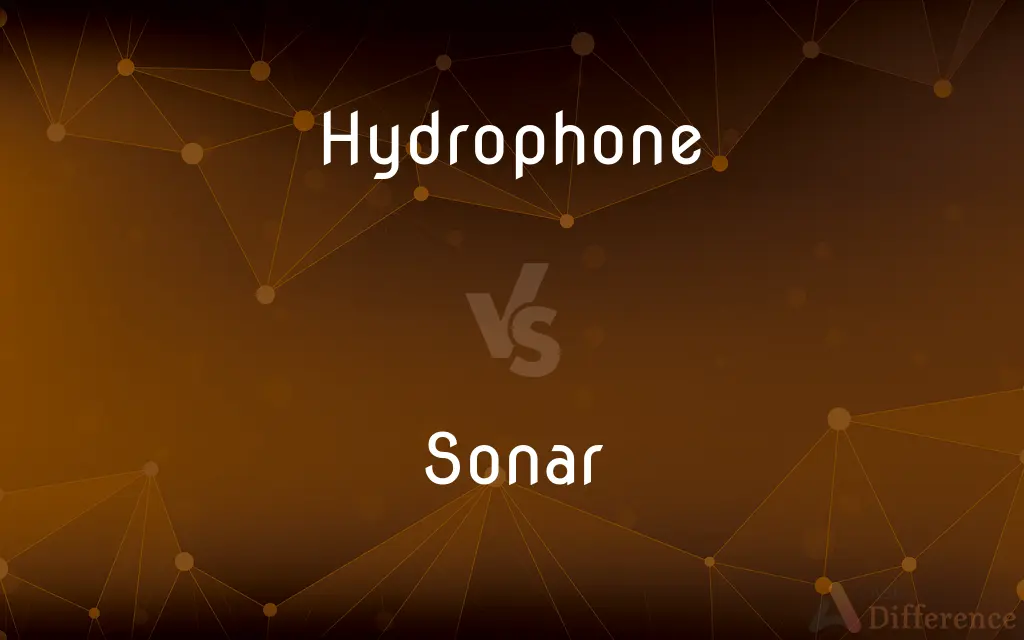Hydrophone vs. Sonar — What's the Difference?
By Tayyaba Rehman & Maham Liaqat — Updated on April 4, 2024
Hydrophones detect underwater sounds; sonar uses sound waves to locate objects.

Difference Between Hydrophone and Sonar
Table of Contents
ADVERTISEMENT
Key Differences
A hydrophone is a specialized type of microphone designed to be used underwater for the purpose of recording or listening to underwater sounds. It is essentially passive, relying on sound waves that travel through water, which it converts into electrical signals that can be analyzed or interpreted. Hydrophones are used in a variety of applications, including monitoring marine life, seismic research, and detecting underwater machinery or vehicles. Whereas, sonar (Sound Navigation and Ranging) is a technique that uses sound propagation under water to navigate, communicate with or detect objects on or under the surface of the water, such as other vessels. Sonar can be passive, like hydrophones, listening for sounds made by other objects. However, it is more often active, emitting its own pulses of sound waves and listening for echoes to determine the location, distance, and speed of objects underwater.
While hydrophones serve as the "ears" underwater, merely listening to sounds, sonar systems can be thought of as both "mouth" and "ears," capable of creating sounds and then listening to the echoes those sounds produce. This fundamental difference highlights the hydrophone's role in passive listening versus the sonar's active engagement in the environment through sound wave transmission and reception.
The technology behind hydrophones is simpler, focusing on capturing sound waves efficiently. In contrast, sonar technology includes both the transmission of sounds and the complex processing of the received echoes to interpret the underwater environment or locate objects. This makes sonar systems more complex and often more expensive than simple hydrophone setups.
The applications of hydrophones and sonar systems also differ. Hydrophones are invaluable in scientific research, including studying marine life behavior and underwater geophysics, because they do not disturb the environment. On the other hand, sonar systems are essential for navigation, search and rescue operations, and military applications, where understanding the location and movement of objects is crucial.
While hydrophones can be used individually, sonar systems are typically part of a more extensive setup that includes signal processing units, transmitters, and often a display to visualize the data collected from the sound echoes, showcasing the integration and complexity of sonar systems compared to hydrophones.
ADVERTISEMENT
Comparison Chart
Function
Detects and records underwater sounds.
Uses sound waves to locate and identify underwater objects.
Operation
Passive, listens to sounds.
Can be passive or active; emits sound waves and listens for echoes.
Complexity
Relatively simple, focusing on sound capture.
More complex, involving sound transmission and echo analysis.
Applications
Monitoring marine life, seismic research, underwater surveillance.
Navigation, detection of objects, military uses.
Environmental Impact
Minimal, as it does not emit sound.
Active sonar can affect marine life due to sound emissions.
Compare with Definitions
Hydrophone
Underwater microphone.
Scientists used a hydrophone to record whale songs.
Sonar
Emits and receives sound waves.
Sonar systems send out pings and measure echoes to locate fish.
Hydrophone
Passive listening device.
Hydrophones monitored the ocean for natural sounds.
Sonar
Used in submarines and boats.
Submarines use sonar for navigation and detecting other vessels.
Hydrophone
Used in marine research.
Hydrophones help study underwater seismic activity.
Sonar
Can be passive or active.
Military vessels often use passive sonar to listen for enemy movements.
Hydrophone
Detects sound waves.
The hydrophone picked up the sound of a distant submarine.
Sonar
Underwater navigation and detection.
The ship's sonar detected an object on the ocean floor.
Hydrophone
Simple design.
The basic hydrophone setup includes just the device and a recorder.
Sonar
Complex systems.
The sonar equipment includes transmitters, receivers, and processing units.
Hydrophone
A hydrophone (Ancient Greek: ὕδωρ + φωνή, lit. 'water + sound') is a microphone designed to be used underwater for recording or listening to underwater sound. Most hydrophones are based on a piezoelectric transducer that generates an electric potential when subjected to a pressure change, such as a sound wave.
Sonar
Sonar (sound navigation and ranging) is a technique that uses sound propagation (usually underwater, as in submarine navigation) to navigate, communicate with or detect objects on or under the surface of the water, such as other vessels. Two types of technology share the name "sonar": passive sonar is essentially listening for the sound made by vessels; active sonar is emitting pulses of sounds and listening for echoes.
Hydrophone
An electrical instrument for detecting or monitoring sound under water.
Sonar
A system using transmitted and reflected underwater sound waves to detect and locate submerged objects or measure the distance to the floor of a body of water.
Hydrophone
A transducer that converts underwater sound waves into electrical signals, rather like a microphone
Sonar
An apparatus, as one in a submarine, using sonar.
Sonar
Echolocation.
Sonar
(nautical) echolocation
Sonar
(nautical) A device that uses hydrophones (in the same manner as radar) to locate objects underwater.
Sonar
A measuring instrument that sends out an acoustic pulse in water and measures distances in terms of the time for the echo of the pulse to return; sonar is an acronym for sound navigation ranging; asdic is an acronym for anti-submarine detection investigation committee
Common Curiosities
What is the impact of active sonar on marine life?
Active sonar can disturb or harm marine life, as some animals are sensitive to sound.
How does sonar work?
Sonar works by emitting sound waves and listening for echoes to identify and locate objects underwater.
Can hydrophones be used to detect submarines?
Yes, hydrophones can detect the sounds made by submarines but cannot actively locate them without other data.
Why would someone use a hydrophone instead of sonar?
For applications requiring environmental monitoring without disturbing the habitat, such as recording marine life sounds.
Can sonar be used above water?
Sonar is designed for underwater use; similar technologies like radar are used above water.
What is the main purpose of a hydrophone?
To detect and record underwater sounds for analysis or monitoring.
How do hydrophones record sound?
Hydrophones convert underwater sound waves into electrical signals that can be recorded and analyzed.
Is it possible to use hydrophones for communication?
While primarily for listening, hydrophones can pick up sound waves from communication sources underwater.
How is sonar used in navigation?
Sonar maps the ocean floor and detects obstacles, aiding in safe navigation for ships and submarines.
What advancements have been made in hydrophone technology?
Advances include improved sensitivity, broader frequency ranges, and integration with other sensors.
Are there any similarities between hydrophones and sonar?
Both use sound waves to gather information from the underwater environment.
What are the components of a sonar system?
A sonar system includes a transmitter, receiver, processor, and often a display unit.
How do environmentalists view the use of active sonar?
Many are concerned about its potential negative impact on marine ecosystems and animal behavior.
Can active sonar detect non-moving objects?
Yes, active sonar can detect both moving and stationary objects by their echoes.
What are the limitations of hydrophones and sonar?
Hydrophones are limited by their passive nature and cannot locate sources without additional data. Sonar's effectiveness can be reduced by factors like water temperature, salinity, and bottom topography.
Share Your Discovery

Previous Comparison
Jeans vs. Chinos
Next Comparison
Metrics vs. MetricAuthor Spotlight
Written by
Tayyaba RehmanTayyaba Rehman is a distinguished writer, currently serving as a primary contributor to askdifference.com. As a researcher in semantics and etymology, Tayyaba's passion for the complexity of languages and their distinctions has found a perfect home on the platform. Tayyaba delves into the intricacies of language, distinguishing between commonly confused words and phrases, thereby providing clarity for readers worldwide.
Co-written by
Maham Liaqat













































